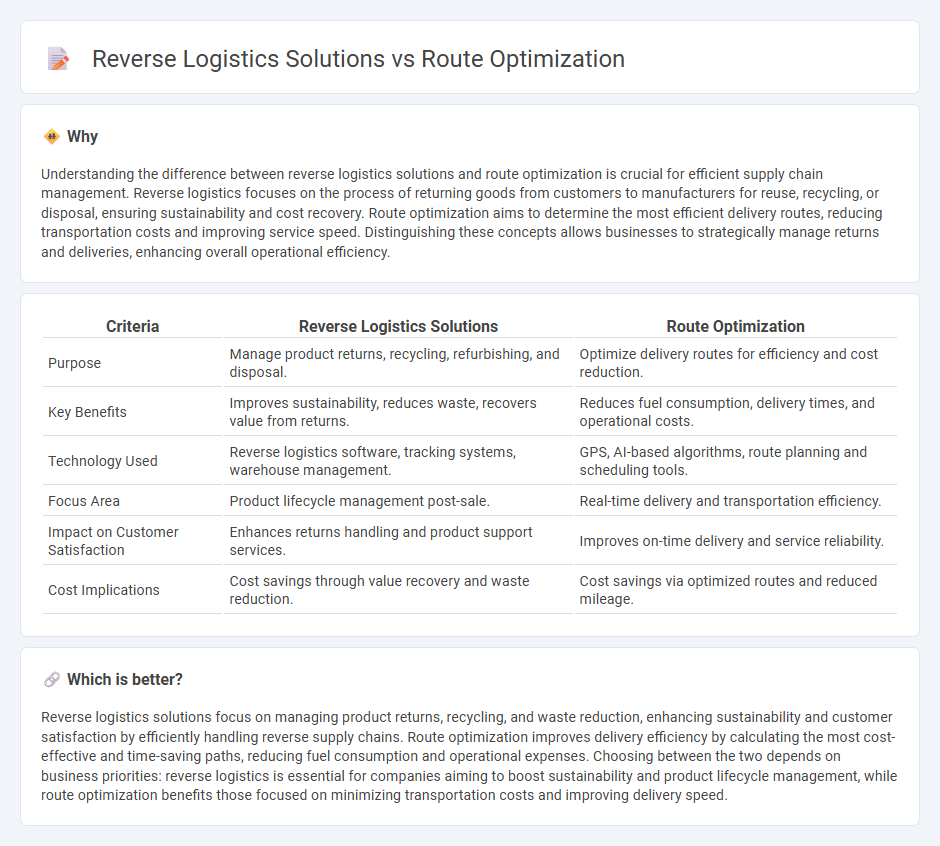
Reverse logistics solutions focus on managing product returns, recycling, and waste reduction to enhance sustainability and cost-efficiency in supply chains. Route optimization improves delivery efficiency by determining the most effective paths for transportation, reducing fuel consumption and transit times. Explore these strategies to streamline your logistics operations and boost overall performance.
Why it is important
Understanding the difference between reverse logistics solutions and route optimization is crucial for efficient supply chain management. Reverse logistics focuses on the process of returning goods from customers to manufacturers for reuse, recycling, or disposal, ensuring sustainability and cost recovery. Route optimization aims to determine the most efficient delivery routes, reducing transportation costs and improving service speed. Distinguishing these concepts allows businesses to strategically manage returns and deliveries, enhancing overall operational efficiency.
Comparison Table
| Criteria | Reverse Logistics Solutions | Route Optimization |
|---|---|---|
| Purpose | Manage product returns, recycling, refurbishing, and disposal. | Optimize delivery routes for efficiency and cost reduction. |
| Key Benefits | Improves sustainability, reduces waste, recovers value from returns. | Reduces fuel consumption, delivery times, and operational costs. |
| Technology Used | Reverse logistics software, tracking systems, warehouse management. | GPS, AI-based algorithms, route planning and scheduling tools. |
| Focus Area | Product lifecycle management post-sale. | Real-time delivery and transportation efficiency. |
| Impact on Customer Satisfaction | Enhances returns handling and product support services. | Improves on-time delivery and service reliability. |
| Cost Implications | Cost savings through value recovery and waste reduction. | Cost savings via optimized routes and reduced mileage. |
Which is better?
Reverse logistics solutions focus on managing product returns, recycling, and waste reduction, enhancing sustainability and customer satisfaction by efficiently handling reverse supply chains. Route optimization improves delivery efficiency by calculating the most cost-effective and time-saving paths, reducing fuel consumption and operational expenses. Choosing between the two depends on business priorities: reverse logistics is essential for companies aiming to boost sustainability and product lifecycle management, while route optimization benefits those focused on minimizing transportation costs and improving delivery speed.
Connection
Reverse logistics solutions improve the efficiency of product returns, recycling, and disposal processes by streamlining the flow of goods from consumers back to manufacturers or distributors. Route optimization algorithms significantly reduce transportation costs and delivery times for reverse logistics by determining the most efficient paths for vehicle fleets handling returned goods. Integrating reverse logistics with advanced route optimization enhances sustainability, reduces operational expenses, and improves customer satisfaction in supply chain management.
Key Terms
**Route Optimization:**
Route optimization enhances delivery efficiency by calculating the most effective routes, minimizing fuel consumption, and reducing transit times for logistics operations. Advanced algorithms and real-time traffic data drive substantial cost savings and improve customer satisfaction through timely deliveries. Discover how route optimization can transform your logistics strategy for maximum operational impact.
Vehicle Routing
Vehicle routing optimization enhances distribution efficiency by minimizing travel distances and delivery times through advanced algorithms tailored for fleet management. Reverse logistics solutions specifically address the efficient return of goods, warranty management, and recycling, often requiring specialized routing strategies to handle varied pickup locations and schedules. Explore innovative vehicle routing technologies to improve both forward and reverse logistics performance.
Dynamic Scheduling
Dynamic scheduling enhances route optimization by using real-time data to efficiently allocate delivery routes, reducing fuel consumption and transit times. In reverse logistics solutions, dynamic scheduling improves the management of returns and recycling processes, enabling faster turnaround and cost savings. Explore how integrating dynamic scheduling can transform your logistics operations for maximum efficiency.
Source and External Links
Route Optimization Basics | OptimoRoute - Route optimization improves routing efficiency and cost-effectiveness by advanced scheduling, balancing workloads, analyzing historical data, and real-time adjustments with software support.
Ultimate Guide to Route Optimization - Routific - Route optimization uses software to import addresses, set constraints, geocode routes, and automatically generate the shortest, most efficient routes with options for manual tweaks.
What is Route Optimization? | Descartes - Route optimization reduces fleet operating costs and improves service by evaluating complex delivery permutations, typically saving 5-10% on fuel and increasing productivity by up to 15%.
 dowidth.com
dowidth.com